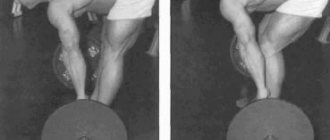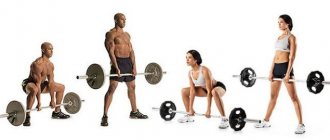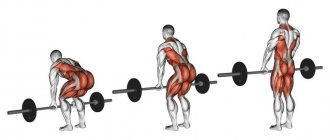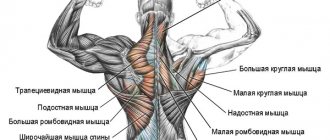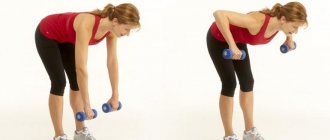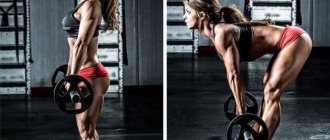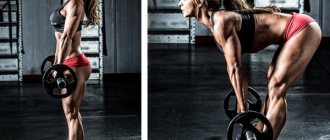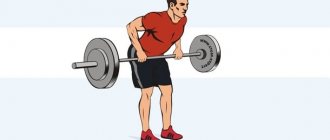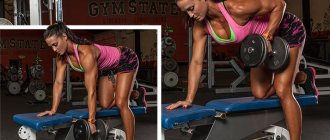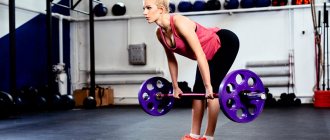Classic deadlifts are not for everyone. Firstly, this complex multi-joint exercise is not recommended for beginners, since the muscles are not yet ready for the traction technique, and secondly, physiologically the exercise causes pain, most often in the lumbar region, and the reason for this is not even diseases and injuries of the spine, but morphological features . And there is an alternative to such an exercise - this is its variation with dumbbells. Let's look at the benefits and disadvantages of the dumbbell deadlift, and whether it's worth replacing the barbell deadlift.
The benefits of dumbbell deadlifts
The classic version of the deadlift, as you know, is performed with a barbell, with the load being distributed to a greater extent on the back muscles, then on the quadriceps, and to a lesser extent on the buttocks and hamstrings. If for men this is most often a mandatory exercise, then for many girls it is not of particular significance or benefit.
It is the deadlift version with dumbbells that is more justified for the female body, since it does not overload the back and quadriceps, and to a greater extent develops the gluteal muscles and hamstrings.
In addition to aesthetic benefits, there are also anatomical ones. That is, for those who are contraindicated in deadlifting with a barbell due to the physiological characteristics of the body, pain and spinal injuries, the option with dumbbells will be more comfortable and safer.
Another morphological aspect is that not everyone is comfortable holding the barbell with an overhand grip, in which the hands are in a pronated position. When holding dumbbells, this moment is smoothed out, since the position of the shoulder joints can be controlled by holding the dumbbells with a parallel, neutral grip.
Analysis of the exercise
What muscles work
Anatomically, the deadlift engages the posterior chain more than the quadriceps. The emphasis is on the hamstrings and glutes, but the quadriceps are also involved in the breakdown. The latissimus dorsi muscles work, and the rhomboids act as stabilizers. The movement is performed through synergistic extension of the hips and legs, and the athlete uses most of the muscles of the body.
The core, as well as the muscles of the palms and forearms, work to hold projectiles and as stabilizers. The movement is also performed with the participation of the trapezius muscles, but they are not the target muscles, so they should be consciously relaxed.
This is a multi-joint exercise that is aimed at working most of the muscles of the body; those who want to isolate the hips and buttocks should do it
The biomechanics exercise is reminiscent of the classic deadlift:
- During the descent, the posterior chain muscles are stretched;
- As the projectile rises, they contract;
- The body is brought into a vertical position by the muscles of the core and back
Pros of exercise
- Possibility of implementation by beginners;
- Suitable for home training and minimally equipped gyms;
- Well suited for correcting classic deadlift technique;
- The exercise is more physiological than moving with a barbell, it allows you to evenly distribute the load between the halves of the body and does not overload the spine;
- Movement helps strengthen not only muscles, but also ligaments;
- Dumbbell rows develop grip
Variations for girls
Many people do not want to pump up their quadriceps, as this increases the size of the hips. Such girls can be advised to perform deadlifts with dumbbells on almost straight legs, the so-called Romanian deadlift. In addition, this option is more conducive to the development of the hamstrings and buttocks.
However, for those who do not have problems with the growth of the quadriceps or who are not afraid of this situation, we can advise you not to change anything in the training and perform a classic deadlift with both dumbbells and a barbell.
Does deadlifting with dumbbells grow your waist? In fact, waist expansion is a genetic predisposition. A wide waist occurs in those who naturally have developed oblique and latissimus dorsi muscles. A deadlift or squat makes little difference here. You just need to maintain a minimum percentage of fat and try not to add additional volume due to fat deposits.
Common Mistakes
- An error in the stance when the legs are positioned so that the toes are spread in different directions;
- The feet are wider than the shoulders, due to which the mechanics of lifting the projectile are disrupted and the exercise becomes difficult;
- Lowering of the head and critical deflection in the thoracic region;
- Lifting the chin up and putting the neck in a dangerous position;
- Lack of fixation of the knees in the upper position;
- Jerking too fast
Proper execution
- There must be a squat in this variation of the exercise; even touching the platform with dumbbells is allowed;
- The dumbbell bars are parallel to each other, or, if brought out frontally, are projected onto the middle of the arch of the foot;
- Arms are straightened, biceps flexion is excluded;
- The breathing technique corresponds to the classic deadlift, exhale as you stand up;
- The projectiles are in contact with the thighs and seem to touch them;
- The exercise can be performed both from a straight stance and from a “pit”; the second option is needed for those whose deadlift technique involves moving with a squat;
- Generally, the hips should be stretched before moving into this technique; bending too deeply indicates a poor stretch. The same can be said about the mistake when a person literally “falls over” on his toes;
- Sometimes the exercise is performed in a technique close to a snatch deadlift, that is, the arms are spread, the trapezius and lats are tense. This allows you to engage your back more;
- The exercise should not be performed in a swing mode;
- You should “insert” your knees and pelvis at the top point of the movement;
- It is not recommended to do this exercise so that when you fall, the dumbbells are pulled with your back;
- You need to carefully straighten up so that the movement comes from your knees;
- The deadlift is less like a squat with dumbbells in your hands and more like a kettlebell swing;
- If there is no pressure of the legs on the platform and the movement occurs due to bending and straightening of the knees, and also the back is not held in the desired position, we are faced with not a deadlift but a squat, therefore we need to change the technique;
- For those who have difficulty grasping the biomechanics of traction, a frontal position of dumbbells is recommended;
- You should start learning with small weights;
If the movement does not work out, you can do deadlifts for a while, sitting on a low box and getting up from it in such a way that there is significant pressure from your legs into the platform
Disadvantages and contraindications for deadlifting with dumbbells
The only disadvantages of the exercise include the requirement for flexibility and elasticity of the muscles and ligaments of the back surface of the body. If there is insufficient flexibility, with tight and shortened muscles, when performing deadlifts with dumbbells, the hamstrings are subjected to strong tension, which can cause serious injuries. Therefore, inflexible and previously injured muscles and tendons should not be subjected to such stress.
Contraindications include spinal injuries, hernias, displacements, protrusions, pinched nerves, and back pain. As well as injuries and inflammation in the muscles and ligaments of the back of the body.
Typical beginner mistakes
Now it’s worth talking about the “rake” that novice weightlifters most often step on.
Back position
This error can be seen in all types of exercises. Trying to lift an unusual weight (and for beginners it is not familiar from the very beginning), the back automatically rounds and hunches. This happens because the practitioner does not keep track of which part of the body he is lifting the weight with.
When the lower back swings, the back should be straight. This position must be maintained throughout the entire tilt. If you can’t hold on, it means you’re not ready to move on yet. Work on stretching the back of your thighs.
Spinal deflection
Being carried away by the muscles of the lower back and legs, beginners forget to monitor the correct position of the neck. You cannot lift your head, twisting the cervical vertebrae, which can lead to neuralgia and impaired blood flow to the brain.
It is necessary to be very careful about the position of the head, trying to pull the top of the head forward, instead of pointing it up when lifting, or down when bending.
It is convenient to control the correct position of the neck using your gaze. When performing basic exercises, look forward, slightly above parallel with the floor. This will create comfort in the cervical region and prevent injury.
Dumbbell position
An equally important point in training. The shells must be kept close to the body to prevent them from falling forward. Dumbbells held far forward with a large weight force the shoulder blades to drop, rounding the upper back. In this position, lifting the weight occurs in a “hump,” which can lead to injury, especially with increased load.
Dumbbells located next to the body ensure synchronized movement, which is safe for the body.
Abuse of sports equipment
On the one hand, equipment helps to cope with heavy weight, but you need to use it in moderation, since with auxiliary equipment your muscles work differently, changing anatomical vectors.
The best way out is not to abuse extreme weights, gradually accustoming the body to stress, but to work without assistants, soberly assessing your physical capabilities.
Exercise should bring pleasure and pleasant fatigue.
When working out with dumbbells, exposing your body to stress, in order to avoid injury, you need to follow simple safety rules. Listen to the sensations and immediately stop training if you have pain in the back, knees, or dizziness, using strength or using the help of specialists, get rid of discomfort.
What muscles work
- Large gluteal muscles.
- Spinal erector muscle.
- Semitendinosus muscle.
- Biceps femoris muscle.
- Semimembranosus muscle.
- Abdominal muscles - perform a stabilizing function.
Technique for performing deadlifts with dumbbells
First of all, let's look at performing deadlifts with stronger knee flexion, which emphasizes the load on the gluteal muscles:
- Take dumbbells in your hands and place the weight on the sides of your hips. Throughout the exercise, the arms always remain straight.
- Place your feet hip-width apart, parallel to each other.
- Bend your knees as if you were squatting and move your pelvis back, while leaning your torso forward as if you were trying to lie on your thighs. Your back should be as straight as possible; under no circumstances should you round your spine.
- As you inhale, lower yourself to the lowest point, but do not lower the dumbbells to the floor, your pelvis should not fall too low, and your knees should not be sharp. Keep your hands in a neutral position along your shins.
- As you exhale, straighten your torso using your gluteal muscles, pushing off with your heels.
Option with emphasis on hamstrings
The second embodiment can be classified as a variation of the Romanian deadlift, in which the knees bend to a lesser extent, which significantly increases the load on the biceps femoris muscles. In this case, the predominant movement is a downward bend, with a slight bend of the knees. When tilting the torso, we move the pelvis back, and the center of gravity shifts to the heels. The spine remains as straight as possible, and the slope reaches parallel with the floor. We lower the dumbbells down with a neutral grip along the shin, without touching the floor.
Equipment in video format
Sumo Deadlift: Theoretical Basics
As usual, you should start with a theoretical basis in order to better understand what exactly happens to the body during the exercise. As you can guess from the name, the sumo deadlift is used mainly by sumo athletes, for whom impressive mass is an important indicator. This type of deadlift is distinguished by the special position of the legs - they are widely spread to the sides, which helps to pump a larger percentage of the muscles during training (in particular, the muscles of the back and legs).
When performing a sumo deadlift, an athlete simultaneously performs 8 movements at once, affecting different muscle groups: straight-arm pulldowns, wrist curls, shrugs, abdominal crunches, back extensions, leg curls, leg presses and, finally, calf raises.
It is also worth paying special attention to the difficulty of performing a sumo deadlift. Research has shown that traditional squats and bench presses, so popular among athletes, cause preliminary stretching of the muscles, which then helps to return the apparatus to its original position. In the sumo deadlift, there is no such stretch - the lifting of the bar occurs solely due to the athlete’s willpower.
Since most athletes have never even heard of the sumo deadlift, it's worth considering the advantages and disadvantages of this exercise compared to the classic deadlift.
Deadlift with dumbbells: recommendations for girls and men
In accordance with the techniques described above, you can place emphasis on certain muscle groups, which means:
- to emphasize the buttocks, follow the first option;
- on the hamstrings – the second.
For beginners in the gym, as well as for girls , it is recommended to perform the exercise with light weight, 15-20 repetitions, 3 sets. The light weight of the load will allow you to develop the correct technique without putting stress on the spine.
For men who are physically fit , it is worth choosing dumbbells of such a weight that it is not possible to perform more than 12 repetitions, so perform 3-4 sets.
Dumbbell deadlifts should be included on leg day; the exercise can be performed after barbell squats or leg presses. It can also be performed with supersets paired with hyperextension or leg curls in the simulator.
Common Mistakes
There are a number of rules for deadlifting. If you do not adhere to them, the desired result will not be achieved. It is worth highlighting a number of the most common mistakes that beginners make:
- Wrong stance. The legs are positioned in such a way that the toes point in different directions.
- The feet are not shoulder-width apart, but slightly further apart. As a result, the lifting technology is disrupted and it becomes much more difficult to perform the necessary actions.
- Strong arch in the chest area and tilt of the head.
- Chin lift. This position is considered extremely dangerous for the neck.
- The knees are not fixed in the upper position.
- The movement is performed very quickly, in jerks.
It is extremely important to observe breathing technique. In this case, exhalation is done when standing up. The projectiles should make contact with the femur and make slight contact with it. You can train both from a straight stance and from the so-called pit. In the second case, the movement is done with a slight squat.
Wrong stance
Strong deflection and tilt of the head
Chin lift
Fixation of knees and speed of movement
